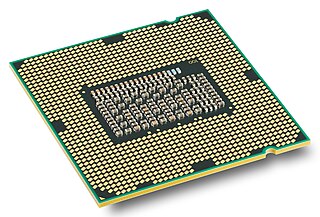
Advanced Micro Devices, Inc. (AMD) is an American multinational semiconductor company based in Santa Clara, California, that develops computer processors and related technologies for business and consumer markets. While it initially manufactured its own processors, the company later outsourced its manufacturing, a practice known as going fabless, after GlobalFoundries was spun off in 2009. AMD's main products include microprocessors, motherboard chipsets, embedded processors, graphics processors, and FPGAs for servers, workstations, personal computers, and embedded system applications.

Cyrix Corporation was a microprocessor developer that was founded in 1988 in Richardson, Texas, as a specialist supplier of floating point units for 286 and 386 microprocessors. The company was founded by Tom Brightman and Jerry Rogers.
Transmeta Corporation was an American fabless semiconductor company based in Santa Clara, California. It developed low power x86 compatible microprocessors based on a VLIW core and a software layer called Code Morphing Software.

ATI Technologies Inc. was a Canadian semiconductor technology corporation based in Markham, Ontario, that specialized in the development of graphics processing units and chipsets. Founded in 1985 as Array Technology Inc., the company listed publicly in 1993. Advanced Micro Devices (AMD) acquired ATI in 2006. As a major fabrication-less or fabless semiconductor company, ATI conducted research and development in-house and outsourced the manufacturing and assembly of its products. With the decline and eventual bankruptcy of 3dfx in 2000, ATI and its chief rival Nvidia emerged as the two dominant players in the graphics processors industry, eventually forcing other manufacturers into niche roles.

Geode was a series of x86-compatible system-on-a-chip microprocessors and I/O companions produced by AMD, targeted at the embedded computing market.
Dell XPS is a line of consumer-oriented high-end laptop and desktop computers manufactured by Dell. The XPS mainly competes against computers such as Acer's Aspire, HP's Pavilion and Envy, Lenovo's X1, Samsung's Sens, and Apple MacBook Pro.
The Intel Graphics Media Accelerator (GMA) is a series of integrated graphics processors introduced in 2004 by Intel, replacing the earlier Intel Extreme Graphics series and being succeeded by the Intel HD and Iris Graphics series.
The 32 nm node is the step following the 45 nm process in CMOS (MOSFET) semiconductor device fabrication. "32-nanometre" refers to the average half-pitch of a memory cell at this technology level. Toshiba produced commercial 32 GiB NAND flash memory chips with the 32 nm process in 2009. Intel and AMD produced commercial microchips using the 32-nanometre process in the early 2010s. IBM and the Common Platform also developed a 32 nm high-κ metal gate process. Intel began selling its first 32 nm processors using the Westmere architecture on 7 January 2010.
Pentium is a brand used for a series of x86 architecture-compatible microprocessors produced by Intel. The original Pentium was released in 1993. After that, the Pentium II and Pentium III were released.

Sandy Bridge is the codename for Intel's 32 nm microarchitecture used in the second generation of the Intel Core processors. The Sandy Bridge microarchitecture is the successor to Nehalem and Westmere microarchitecture. Intel demonstrated a Sandy Bridge processor in 2009, and released first products based on the architecture in January 2011 under the Core brand.

AMD Accelerated Processing Unit (APU), formerly known as Fusion, is a series of 64-bit microprocessors from Advanced Micro Devices (AMD), combining a general-purpose AMD64 central processing unit (CPU) and integrated graphics processing unit (IGPU) on a single die.
Tilera Corporation was a fabless semiconductor company focusing on manycore embedded processor design. The company shipped multiple processors, including the TILE64, TILEPro64, and the TILEPro36, TILE-Gx72, TILE-Gx36, TILE-Gx16 and TILE-Gx9.

VideoCore is a low-power mobile multimedia processor originally developed by Alphamosaic Ltd and now owned by Broadcom. Its two-dimensional DSP architecture makes it flexible and efficient enough to decode a number of multimedia codecs in software while maintaining low power usage. The semiconductor intellectual property core has been found so far only on Broadcom SoCs.

Intel Graphics Technology (GT) is the collective name for a series of integrated graphics processors (IGPs) produced by Intel that are manufactured on the same package or die as the central processing unit (CPU). It was first introduced in 2010 as Intel HD Graphics and renamed in 2017 as Intel UHD Graphics.
Intel Quick Sync Video is Intel's brand for its dedicated video encoding and decoding hardware core. Quick Sync was introduced with the Sandy Bridge CPU microarchitecture on 9 January 2011 and has been found on the die of Intel CPUs ever since.

Ivy Bridge is the codename for Intel's 22 nm microarchitecture used in the third generation of the Intel Core processors. Ivy Bridge is a die shrink to 22 nm process based on FinFET ("3D") Tri-Gate transistors, from the former generation's 32 nm Sandy Bridge microarchitecture—also known as tick–tock model. The name is also applied more broadly to the Xeon and Core i7 Ivy Bridge-E series of processors released in 2013.

The Intel AZ210, also marketed as XOLO X900 in India, Orange San Diego in the United Kingdom and Megafon Mint in Russia, is a phone manufactured by Taiwanese OEM Gigabyte for Intel.









